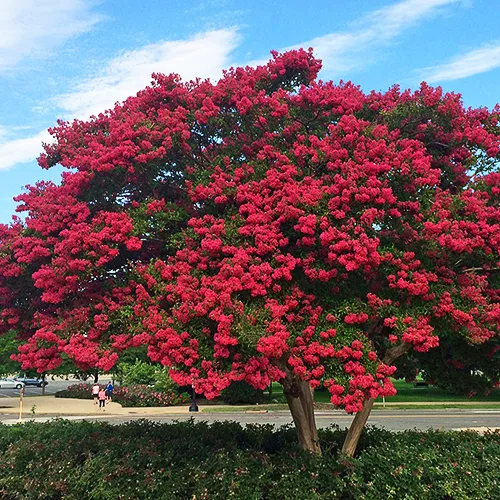The History Of Red Crepe Myrtle
Red Crepe Myrtle A Tree Steeped in History
The roots of this stunning Red Crepe Myrtle extend deep into Asian history, spanning several hundred years. Chinese botanists identified this tree as being originally from China and Southeast Asia, where it thrived under warm and moist conditions. Ancient Chinese botanists grew this plant because its flowers were very attractive, and its bark peeled gracefully while also withstanding drought conditions. The tree migrated to Europe during the 18th century and soon gained value as a sought-after component of botanical collections.
Its arrival in North America occurred during the late 18th century when it flourished under Southern climate conditions. The plant established itself as an essential feature in estate gardens by providing colorful displays along walkways and roads. The combination of its preference for warm and arid environments, along with its tolerance for poor soil conditions, led early American horticulturists to favor this plant. Through selective breeding over time, gardeners managed to improve this plant's color and shape, which produced brighter flowers and stronger plants. The plant continues to be a classic selection for landscape design because of its lasting attractiveness.
Traditional and Modern Medical Uses
This tree stands out for its beauty, but traditional Eastern medicine acknowledges its medicinal benefits. Generations have used bark, leaves, and flowers in different medicinal preparations. Chinese medicine practitioners used bark infusions to treat digestive conditions such as bloating and indigestion. Traditional healers treat minor wounds and skin irritations by using crushed leaves as an anti-inflammatory agent.
Recent scientific research has examined the Red Crepe Myrtle chemical structure and identified antioxidant and antimicrobial properties in specific compounds found in its bark. Researchers have investigated its possible uses in diabetes treatment because preliminary research indicates that it may offer blood sugar regulation capabilities. The medical community remains interested in its historical use in herbal medicine due to the fact that scientific studies about it are in their initial phases.
A Floral Marvel in Landscaping
This tree embodies the spirit of summer better than any other tree. The tree's ability to adapt along with its hardiness makes it ideal for integration within city environments, suburban homes and expansive garden areas. Urban designers implement this tree along roadways and thoroughfares to provide vibrant color with minimal upkeep. The tree serves as the centerpiece in residential landscapes because its dramatic flowers create a spectacular show from early summer until fall.

This hardy plant thrives in extreme heat and drought conditions which makes it perfect for sandy or dry soil environments. The tree requires less maintenance compared to many flowering tree species. Regular pruning maintains its form and stimulates healthy growth yet this tree requires little additional care. Landscapers choose this plant for its attractive multi-seasonal appeal because its smooth peeling bark maintains visual interest throughout winter months while its bare silhouette remains striking.
Red Crepe Myrtle A Vivid Display of Nature’s Beauty
The tree stands as an absolute visual wonder wherever it grows. The tree displays vibrant crimson flowers beginning in early summer which form dense clusters that remain striking until autumn. The flowers display a crinkled and fragile appearance that looks like crepe paper thus inspiring the species' name. The delicate ruffles of the flowers stand out against the dark green leaves of the tree to create an ever-evolving dramatic display that transforms with each passing season.
When temperatures drop, the leaves display striking orange and deep red colors, which enhance the tree’s visual appeal after the flowering season has ended. The distinctive bark of Red Crepe Myrtle peels away to show smooth wood with a cinnamon color underneath. The tree remains a remarkable specimen throughout the year because of its flowering splendor combined with its colorful leaves and distinctive bark shape.
A Haven for Rare Wildlife
This tree supports local ecosystems while also serving as an ornamental feature. Nectar-rich flowers attract bees and butterflies as primary pollinators. Blossoms appear in great numbers which gives pollinators a reliable food supply during summer months thus making this plant crucial for maintaining these helpful insects.
Hummingbirds regularly appear throughout the garden, moving rapidly between flowers in search of nectar. The presence of these birds contributes to garden vitality and makes this tree ideal for anyone who wants to see these stunning birds visit their garden. The leaves of this plant serve as a host plant for particular moth and caterpillar species, which helps increase the biological diversity of its environment.
Small songbirds find refuge in its branches which they utilize as both shelter and nesting sites. This tree provides essential sustenance and protection which makes it vital for wildlife in urban areas where green spaces are limited. The planting of this tree transforms the landscape while maintaining natural equilibrium.
Red Crepe Myrtle A Timeless Treasure
Red Crepe Myrtle has fascinated both garden enthusiasts and nature admirers for hundreds of years because of its stunning mix of aesthetic appeal and environmental benefits. Its historical Asian origins and modern landscape popularity make this tree beloved for its colorful blossoms and distinctive bark, along with its ability to support wildlife. This tree stands as a symbol of natural elegance and strength regardless of whether it lines city streets, adorns suburban gardens, or stands alone in rural meadows to secure its position in horticulture for future generations.